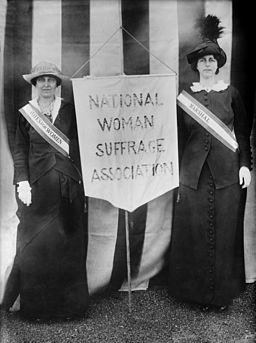The Seneca Falls Convention (1848):

The convention in Seneca Falls, NY, was the first organized formal demand for equal rights for women in the United States, and is considered the birthplace of the women’s suffrage movement. It brought together two hundred women and forty men, including feminists Elizabeth Cady Stanton and Lucretia Mott, along with social reformer and former slave Frederick Douglass, to make the claim for full citizenship.
There were different approaches to the issue. Some delegates completely rejected the limitations of Victorian domesticity, with its separation of women and men into private and public spheres, respectively. They saw the concept of women’s suffrage as just part of a larger movement for women to gain civil and legal equality.
Others took a more conservative approach, and set out to show that rather than disrupt the social order, women’s suffrage would instead maintain it. Bringing their “natural” roles as mothers and nurturers into the public arena, women would be able to impose what Jane Addams later termed “civic housekeeping” upon the competitive and corrupt (male) state. The feminization of government would act as a means of reform and encourage a more nurturing role of the state toward its people.
Here’s what female suffragist Reverend Anna Garlin Spencer said about this new role of government:
…the instant the State took upon itself any form of educative, charitable, or personally helpful work, it entered the area of distinctive feminine training and power, and therefore became in need of the service of woman.
Women like Spencer, representing the mainstream, moderate suffrage movement, were not arguing for a complete transformation of their role in society, but rather a conservative extension of it.

In preparation for the convention, Elizabeth Cady Stanton wrote a “Declaration of Sentiments” – modeled after the Declaration of Independence – that was presented before the delegates. Like the original Declaration, it is a list of grievances and injustices, although here the injustices specifically endured by women in society. It’s a powerful document. Here’s a sample (to read the entirety, click here):
The history of mankind is a history of repeated injuries and usurpations on the part of man toward woman, having in direct object the establishment of an absolute tyranny over her. To prove this, let facts be submitted to a candid world.
He has never permitted her to exercise her inalienable right to the elective franchise.
He has compelled her to submit to laws, in the formation of which she had no voice.
He has withheld from her rights which are given to the most ignorant and degraded men–both natives and foreigners.
He has created a false public sentiment by giving to the world a different code of morals for men and women, by which moral delinquencies which exclude women from society, are not only tolerated, but deemed of little account in man.
He has usurped the prerogative of Jehovah himself, claiming it as his right to assign for her a sphere of action, when that belongs to her conscience and to her God.
The National Portrait Gallery has more about the Seneca Falls Convention, along with links to pictures that you can check out.

We know how it all turned out 72 years later, right? Ah, but did you know that it came down to one young man in Tennessee, who listened to his mother? Check out my post, The Right to Vote, to find out more!


We take for granted all that was done to give us the right to vote when we don’t vote. Great post.